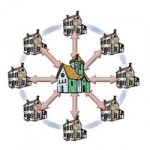A different kind of building
Three years ago, I wrote a post called “A different kind of building.” This post investigates some of the metaphors that Paul uses for the church in Ephesians. Primarily, I look at the combination of building and planting. The church (the people) are the house of God, but we are a different kind of building.
———————————————————-
When someone builds a building, when it is complete, at that moment it is the most resplendent that it will ever be, barring future improvement. From the moment that the building ceases, the edifice begins to deteriorate. Thus, when the building stops, the unbuilding begins. This is the nature of our fallen world.
When construction was completed on Solomon’s Temple and when the temple was dedicated, the temple was as beautiful and as perfect as it would ever be. The wood was now rotting. The stone began to crack and chip. The gold would flake off. In other words, the building would begin to unbuild itself. As you read the biblical account, you will see that there were many instances where people repaired the temple because it was falling apart.
There is a different kind of building – a building that does not unbuild – a building that does not fall apart as soon as construction is complete. In fact, this building continues to become more and more complete. It does not deteriorate. Instead, its beauty is continuously growing. What building? You and me and the entire building of God – the church.
This is what Paul wrote in Ephesians:
So then you are no longer strangers and aliens, but you are fellow citizens with the saints and members of the household of God, built on the foundation of the apostles and prophets, Christ Jesus himself being the cornerstone, in whom the whole structure, being joined together, grows into a holy temple in the Lord. In him you also are being built together into a dwelling place for God by the Spirit. (Ephesians 2:19-22 ESV)
Unlike other buildings, the household of God – the building of God – the temple of God is not build on dead stone or earth. It is built on a living, breathing Lord. The whole edifice being built, is joined together, and is growing because of Jesus Christ and him alone. Notice the emphatic phrase “Christ Jesus himself”, and then the two relative clauses”in whom” and “in him”. Since the Cornerstore is alive, the building is alive. Since the building is connected to Christ, the building continues to be built, continues to be joined together, and continues to grow. This building does not deteriorate; it grows more and more resplendent.
Unlike other buildings, this building is not made of dead material. Instead, this building – this dwelling place of God – is being built of living stones (as Peter puts it) – stones which have been given life by their Lord, who is also their architect, their builder, and their cornerstone. Paul combines the metaphors of building and gardening specifically because this is a different kind of building – a growing building – a living building. He combines these metaphors again in chapter 4:
[W]e are to grow up in every way into him who is the head, into Christ, from whom the whole body, joined and held together by every joint with which it is equipped, when each part is working properly, makes the body grow so that it builds itself up in love. (Ephesians 4:15-16 ESV)
He also combines these metaphors of construction and gardening in 1 Corinthians:
I planted, Apollos watered, but God gave the growth. So neither he who plants nor he who waters is anything, but only God who gives the growth. He who plants and he who waters are one, and each will receive his wages according to his labor. For we are God’s fellow workers. You are God’s field, God’s building. According to the grace of God given to me, like a skilled master builder I laid a foundation, and someone else is building upon it. Let each one take care how he builds upon it. For no one can lay a foundation other than that which is laid, which is Jesus Christ. (1 Corinthians 3:6-11 ESV)
We are both God’s building and God’s field (or garden) because together we make up a living building – a building which is alive with the life of Christ and grows through the power and working of the Spirit. This is truly a different kind of building.
Commenting on this building, Peter O’Brien said the following in The Letter to the Ephesians (Grand Rapids: Eerdmans, 1999):
There is a mixture of building and organic images in the statement that the whole structure is ‘being joined together’ and is ‘growing’ into a holy temple in the Lord. The cornerstone unites the building ‘because it is organically as well as structurally bound to it’. So to speak of the building being joined together refers not simply to the union of one stone with another, but also to the union of the whole structure with (and in) the cornerstone. Both verbs, which occur again in 4:15, 16, focus on the idea of continuous progress. There, in a similar mixing of metaphors, the body is ‘joined together’ and ‘built up’ from Christ the head. (pg. 219 – emphasis in original)
The building exists because of Christ, who is both the head and the cornerstone. The building is joined together because of Christ. And the building grows because of Christ. Just as he has given life to dead people (Ephesians 2:1-10), he has also given life to a dead building.
O’Brien said that the two verbs “joined together” and “built up” focus on continuous progress. Thus, this building – which is built, joined together, and growing – is continuously progressing and continuously growing and continuously becoming more beautiful toward some final outcome. What is the goal of this progress?
…until we all attain to the unity of the faith and of the knowledge of the Son of God, to mature manhood, to the measure of the stature of the fullness of Christ… (Ephesians 4:13 ESV)
The final outcome of this building progression will be complete unity – both with one another and with God – and complete maturity – measured against Christ himself. We are progressing, but we are not there yet. How beautiful this building will be when we reach unity and maturity! Of course, there is still much disunity and immaturity today. But, how amazing it is to be part of this dwelling place of God – a growing, changing, moving, working temple – which is an altogether different kind of building.
Do you know what is written?
As you know, the focus of my blog is the church, and primarily the assembling of brothers and sisters in Christ. Because of that, people (in real life) often ask me about my beliefs about the church.
(Interestingly, I rarely bring up the topic myself. Instead, I try to live it out as an example.)
Since my ecclesiological beliefs (understanding of the church) are different than many people’s beliefs, there are often disagreements when I’m talking with someone about the church. I’m not upset or disappointed when someone disagrees with me, especially when those disagreements come from different interpretations of Scripture.
But, what I’ve found is that most people don’t know what the Scriptures say about the church. Those same people usually have very (very) strong convictions about the church. But, when I ask about Scripture, they usually say something like, “Well, I haven’t studied that like you have.”
Like I said, it’s perfectly fine when someone disagrees with my interpretation of Scripture. But, I’m very confused when someone stands steadfastly on a certain belief about the church, but that person knows very little about what Scripture says about the church.
Do you want to disagree with my understanding of the church? That’s fine. But, could you read what Scripture says about the church first?
The birth of a church
Guy at “The M Blog” has written a very important post called “How to start a house church.”
According to Guy, only two things are needed to start a house church: 1) Gather people and 2) make disciples. He offers some examples from his own experience, but he settles on these two main points as necessary.
(By the way, I stole the picture from Guy’s post “It’s all about Jesus,” which include “faces and scenes” of house churches in Guayaquil, Ecuador, where he lives.)
So, if Guy correct? Is gathering people and making disciples (assuming that we’re making disciples of Jesus Christ) all that we need to be a church?
If not, then what is missing? If so, then what happens when other things are added as necessary or important?
Upgrade Church or Downgrade Church?
Jeremy at “Till He Comes” has written a great post called “Upgrade Your Church.”
He recently “upgraded” some of his websites, but the upgrade caused his sites to be slower. So, Jeremy ended up reverting back to the original version of his sites.
Next, Jeremy uses this experience as a metaphor for the church. Do we need an upgrade? Do we need to revert to an older version? You can read his comments on each part of this metaphor.
But, I really like the way that Jeremy ended his post:
Transitioning to a house church model is not a “revert†back to the way it was in the book of Acts. It is actually an upgrade from the institutional model to a more streamlined, service-oriented, all-inclusive, everybody-has-a-say operating system with fewer scripts, plugins, coding errors, and restrictions. And definitely no “Are you human?†codes to decipher.
So, have you upgraded your church recently? If so, how is it functioning?
Now, as most of my readers know, I’m not a house church proponent. However, I definitely agree that changing from a more traditional and institutional way of understanding the church toward a more organic and simple way of understanding the church is a great upgrade!
No, I’m not interested in reverting back to Church 50AD. However, I think we can learn alot from Church 50AD in order to understand and live as Church 2100AD.
(By the way, while you’re reading Jeremy’s post about upgrading the church, you may also want to read an article that he wrote for The Ooze called “The Humanizing Church.” Great stuff!)
Local Church in Scripture
Three and a half years ago, I was investigating the modern (and traditional) understanding of “local church.” One of the posts that I wrote about this is called “Local Church in Scripture.” Are we excluding brothers and sisters in the way we that define “local church”? Do we find this same kind of exclusion in Scripture?
———————————————-
What do you think of when you hear the phrase “local church”?
Do you think of a building on the corner with a steeple? Most believers will admit that this is not a church, but may be a building where a church meets. But, what about the people who meet there?
Is the local church a group of believers who meet regularly at a specific place and at a specific time? Does a regularly meeting define a “local church”? Again, most believers will accept that someone may be part of a “local church” even if that person cannot meet at each regularly scheduled meeting. So, what about membership?
Is the local church defined by a list of names on a membership role? Again, when push comes to shove, most believers agree that a membership list does not define a “local church”. There could be people on the list who are not believers, and perhaps there are people who are part of the local church whose names are not on the list.
So, what is the local church?
Let me ask a few questions about Scripture…
1) When did Paul “join” the church in Jerusalem, or Tarsus, or Antioch, or Corinth, or Ephesus? What about Barnabus, Luke, Timothy, Titus, etc? When did they “join” a particular “local church”? What about Priscilla and Aquila? When did this couple join the church in Corinth or Rome?
2) At what point were these individuals members of one local church or another? When did they consider themselves part of the church in Corinth, or Ephesus, or Thessalonica, or Rome? When did they not consider themselves part of those particular churches?
3) At what point did the particular local churches recognize these individuals as part of their church? When did they not recognize these people as part of their church?
4) Where does Scripture give us an example of a believer moving into an area and then being required to do something to “join” the church in that area? Where does Scripture give us an example of believers covenanting with one another in order to be a local church?
I am not suggesting that “joining” a local church is wrong or bad. It is not unscriptural to have your name on a membership list – it is ascriptural though – that is, not found in scripture. However, if we cannot find this commanded or even described in Scripture, should we make this a necessary step of recognizing someone as a part of the “local church”?
Breaking it down
A question that I have asked often on my blog (because I continue to ask and study the question myself) is this: at what point is a group of Jesus’ followers the church?
One of the ways that people have traditionally examined this question is to investigate how a particular group treats sub-groups. Or, to put this in more traditional terms, how does a church treat the small groups that are part of that church.
Guy at “The M Blog” has posted on one such summary in his post “What is the difference between a small group, cell church, and house churches?” He provides the following information (taken from a book listed in his post):
On one end of the spectrum, for instance, is the traditional church…[that] uses small groups (often misnamed ‘cell groups’)–this can be described as a ‘church WITH small groups.’
Further along the spectrum is the cell church that places an equal or greater emphasis on its mission-minded small groups (properly called ‘cell groups’) compared to its weekly large group services–this can be described as a ‘church OF small groups.’
However, the house church network sees each house church as a fully fledged, autonomous, church in itself–‘church IS small groups‘.
Guy also provides the following diagram:
Now, as Guy points out in the comments, the definitions and descriptions above are generalizations. But, for many, these are good starting points.
However (and unfortunately), I don’t think these definitions and descriptions answer the question that I’ve been asking. Let me explain. In the traditional and cell church models above, a subgroup of one of those churches would generally NOT be considered the church. But, what about in the “house church network” model? Would a subgroup of one of the house churches be considered the church?
Suppose a particular house church is composed of six families. Now, suppose that three of those families met together one evening. Would the “house church” consider those three families meeting together the church? Maybe. The definitions and descriptions do not tell us.
In fact, the only difference in the three models given above is the point at which a certain group or subgroup is recognized as the church. The models do not tell us if a sub-sub-group would also be recognized as the church. The models do not tell us if a mixed subgroup would be recognized as the church.
Each of the above models shares one very important aspect in common: the people decide at what point and in what setting they recognize themselves as the church. The number of people is not an issue here. If half the “members” of the traditional church, cell church, or house church show up to meet together, it is considered “the church” only if the group has decided it is “the church.” Typically, this is an organizational decision, regardless of the size of the organization.
On a Sunday morning (or whenever), those people would be the church. On a Wednesday (if it is set aside for such), they are the church. But, what about Friday evening at a local high school football game? What about at a birthday party or baby shower?
For me, this is the weakness in each of the models listed above. The people are recognized as “the church” by their own definition and delineation. They decide when they are or are not “the church,” and they decide which subgroup (parts of the whole) or supergroups (additions to the whole) are or are not the church.
When I break it down, (in my understanding) each of the above models actually represents the same explanation of what it takes for a group of Jesus’ followers to be “the church.” What do you think?
I think that it is very important for us to think about when we consider ourselves “the church” and when we do not. Agree or disagree? Why?
Church, Churches, and Questions
On New Year’s eve, while our family was driving back home from Alabama, a reader named Rob started a good conversation on an older (almost a year old) post of mine called “What does it take to be a church?”
Since many of you may have missed the conversation, I wanted to post Rob’s last comment (which includes two very good questions) as a “guest blog post,” and Rob gave me permission. (If you’re interested, jump back to the original post and read the discussion at the end of the comment thread between Rob, Art, and myself).
Here is Rob’s final comment:
I don’t see any indication that the “churches†of a region considered themselves exclusive of one another either. They seem to have been interrelated and mutually supportive through the movement of ministries amongst them and expressed as in the support of the poor in Jerusalem. But we have no evidence of hierarchical structures ruling over regions hence the plural of ‘churches’ for regions but singular for cities and households. There is no example of elders in one city carrying administrative authority in any other city.
Yes we have come a great distance from the biblical pattern and I agree it was never perfect and perhaps far from it. I have 2 QUESTIONS I think are valuable to consider:-
1) How do we relate to the church in our locality maintain and express unity despite the labels and divisions. In UK (my place of origin) and Barbados my current residence I find that denominational labels mean little compared with previous generations (I do not know if this is the same in the US). The majority of people move among the churches much more on the basis of a) whether the church provides for their needs / wants or b) where they find genuine friends, which is a better motive. However I would like to see more believers being concerned with where they could best meet the needs of others.
The approach I favour is to ignore the labels and build relationships wherever they can be beneficial to the kingdom. We are associated with a network of churches – some of which are house churches, some are cell churches some are also part of various denominations.
2) Do we have hope and / or Biblical grounds for expecting church reformation and a perfecting of the church prior to Christ return e.g. Eph. 4 “maintain the unity of the Spirit … until we cone to the unity of the faithâ€. Does this ‘until’ hold out any promise of its eventual accomplishment?
How would you answer Rob’s questions?
Building something that lasts?
I was talking with a friend recently about the people who are part of the church with us. If you remember, several people moved out of the area last summer. Also, there are several families who are looking for jobs or who are considering moving for other reasons.
My friend asked me if I was concerned that if more and more people move out of the area, then our church might cease to exist.
This questions took me by surprise, because I honestly had not even thought about it. Why? Because I don’t think about the church in that way anymore.
You see, if the people are not meeting together, then the church does cease to exist. Of course, organizationally, something called “Messiah Baptist Church” (what we all ourselves) might still exist, but the church – that is, the people who are meeting together – will not be meeting together any longer.
Let me give you an example. Let’s assume, for this example, that exactly 50 people and only those 50 people meet together. Let’s also assume that these people all themselves “Our Community Church.” Not, what happens if those 50 people all stop meeting together as the church (for various reasons), but 50 different people now meet together and continue to call themselves “Our Community Church.”
Even though the new group calls itself by the same name, it is a different group of believers. The church is different. It is not the same. In fact, since none of the same people remain in the second group, “Our Community Church” is now a completely different church.
However, many believers and churches are spending time, energy, and resources to make sure that the organization (whatever they call themselves, however they are organized, whatever their creed or confession, wherever they meet) continues after the people are gone. They are building into an organization.
Our focus should be building into the lives of people. Thus, as I see it, when those 50 people disperse, the church continues through the lives of those 50 people, not through the continuing organization.
Even now, there are people around the world who have spend time with me and my family, who have helped us grow in Christ, and who we have helped in turn. Dispersal of a group of people – while always painful if the people are truly a church in the scriptural sense – can be very good for the kingdom of God.
So, after thinking for a while, I told my friend, “No, I’m not concerned with whether or not ‘Messiah Baptist Church’ continues to exist if all the people move away. However, I am concerned that the people involved continue to proclaim the gospel, build up other believers, and serve people that God brings into their lives. In this sense, the church will continue, wherever we are and whatever we are doing.”
What’s with this “small group” stuff anyway?
So, I’m reading a book right now about “small groups.” The book is about leading your “small group” to be a certain type of “small group.” (By the way, I like alot of things about this book, and I’m sure that I’ll write more about it soon.)
In order to back up their claims, the authors use Scripture, of course. But, I’ve noticed that the Scripture that they use typically refers to the church. The NT writers were describing the church, and these authors have taken the Scriptures and applied them to “small groups.”
Here’s the thing, in the book, the authors are clear that they are describing “small groups” which are part of the church but are not the church in and of themselves.
The “small groups” that the authors describe meet together, pray together, study Scripture together, serve others together, proclaim the gospel together, fellowship together, etc. But, according to the authors, the “small groups” are not the church.
So, why not? What is it that makes “small groups” into “small groups” but not the church? What do “small groups” lack that keep them from being the church?
Is there anything in Scripture that differentiates between a “small group” of Christians and a church?
We’re not “called out”
Recently, I’ve posted a few quotes from commentaries in which the authors say that the Greek term ekklesia (usually translated “church”) means “assembly” and not “called out ones.” Why is this important?
The idea of the church being “called out” usually leads to the conclusion that the church is called out of the world. But, this is exactly opposite of what Jesus taught. In his prayer in John 17, Jesus prays:
I do not ask that you take them out of the world, but that you keep them from the evil one. They are not of the world, just as I am not of the world. (John 17:15-16 ESV)
Jesus specifically prays that his followers (the church) remain in the world, not that they would be taken out of the world (or “called out of the world”).
Unfortunately, so many have accepted this idea that God has called his people out of the world that they then need to figure out how to get back to the world in order to carry out God’s mission.
What’s the answer? Stay in the world… stay connected to the world… maintain relationships with the world… build relationships with the world… remain in the world, even though our source of strength, power, hope, salvation, etc. is not from the world (“of the world”).
As the church, we are assembled by God in the world. We are not called out of the world; we are called into the world.











